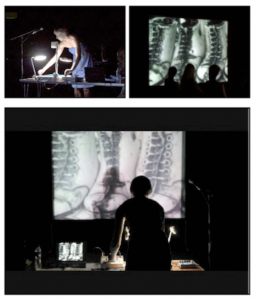Dispersed and Dislocated: The construction of liveness in live intermedial performance
Cormac Power (2008) …. [highlights] the key aspect of the liveness of a performance, as opposed to a live recording or broadcast, which is ‘the potential for discourse between the processes of presentation and the processes of preparation…and reception’, which ‘are never finished until the performance is ‘finished” (in Power 2008: 157).

Scott, J., 2012. Dispersed and Dislocated: The construction of liveness in live intermedial performance. Body, Space & Technology, 11. DOI: http://doi.org/10.16995/bst.75 (Downloaded on 25th of April 2020)
Abstract
This article focuses on an analysis of the live intermedial performance, The Mark of Affect. Using the theories of Philip Auslander (2008), Erika Fischer-Lichte (2008) and Roberta Mock (in Power 2008) as a starting point, three moments from the performance are analysed in relation to liveness; specifically, how it is constructed and manifests itself within this performance. In all cases, the combinations of live and mediatised acts are seen as creating hybrid forms of liveness, which exist both within and through the technology employed on stage.
[…]
Three broad aspects of liveness in performance emerge from this debate, could be summarized as follows:
- At the same time – the ‘temporal simultaneity’ cited by Auslander, Mock and Fischer-Lichte, where spectators’ and performers’ temporal experience of the performance coincides
- In the same place – Auslander’s ‘physical co-presence’ of spectators and performers sharing the same space, which is echoed by Mock and Fischer-Lichte
- In real time – Mock and Fischer-Lichte’s assertion that the performance unfolding in the moment of its reception by the spectator makes it variable, ‘unfinished’ and engenders ‘unpredictability’ or ‘liveness’ because of this
Cormac Power however claims that ‘liveness is not an ontological property of theatrical performance, but a constructed, mediated experience’ (2008: 161). He also asserts that liveness ‘as a term is concerned with a narrow and rather idealistic notion of unproblematic immediacy’, suggesting that it ‘is a relatively limited notion that applies only to events within a technological context’ (Power 2008: 166).
Building from such notions of liveness and Power’s contentions, I will argue in this analysis of a live intermedial performance, that it is specifically the existence of liveness ‘within a technological context’ on the intermedial stage, which extends and expands the possibilities inherent within the term. Within this context, liveness is indeed both ‘constructed’ and ‘mediated’, but it is also through this process that liveness is allowed to inhabit performance in a distinct and dislocated format.
it is specifically the existence of liveness ‘within a technological context’ on the intermedial stage, which extends and expands the possibilities inherent within the term.